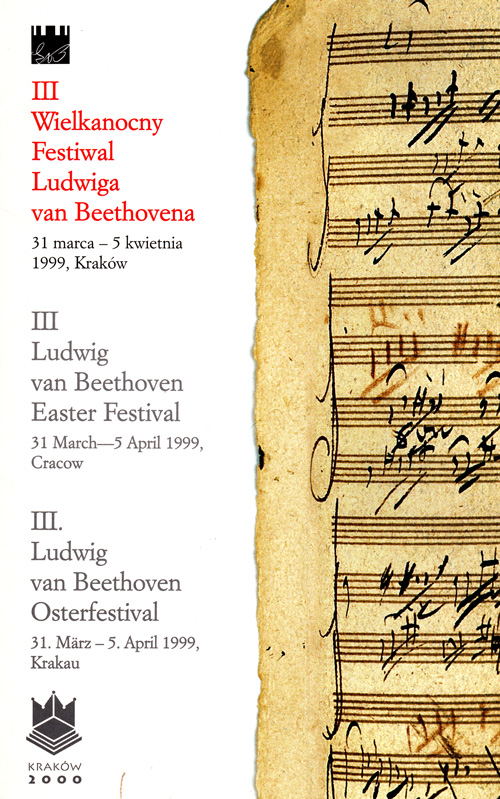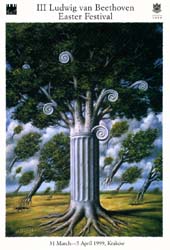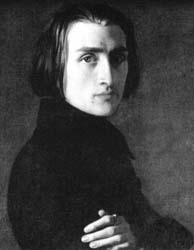Ludwig van Beethoven Easter Fetival in Cracow 1999
1. April 1999
Konzertsaal der Staatsphilharmonie Krakau
Tatiana Zacharczuk (Sopran) - Malgorzata Walewska (Mezzosopran)Zachos Terzakis (Tenor) - Jyrki Korhonen (Bass)
Chor der Nationalphilharmonie, Warschasu
Chorvorbereitung: Henryk Wojnarowski
Das Nationale Sinfonieorchester des Polnischen Rundfunks, Katowice
Leitung: Antoni Wit.


 Download the Poster |
Thursday, 1 April, 19:30 Ferenc Liszt Christus (1866)Part III. Passion und Auferstehung.No. 12 Stabat MaterNo. 14 Resurrexit |
 Ferenc Liszt, 1838 |
Polish National Radio Symphony Orchestra, Katowice
National Philharmonic Choir
Antoni Wit -
conductorSoloists:
Malgorzata Walewska - mezzosoprano,
Zachos Terzakis - tenor,
Jyrki Korhonen - bass
Andrzej Bialko
- OrganHentyk Wojnarowski
- choir masterFerenc Liszt Christus oratorio for five soloists, choir, organ and orchestra
Stabat Mater and Resurrexit are fragments (Nos 12. and 14.) of the oratorio Christus written between 1862 and 1866 in a late period of Liszt's oeuvre. The composer stayed mainly in Rome took holy orders and concentrated on religious themes. Pain and death were his chief fascinations then. He was writing - apart from The Legend of St. Elizabeth ,motets for choir, and masses - threnodies, funeral marches, ad memoriam works, Requiem, and finally his last great composition, Via crucis
. II. Nach Epiphania (After the Epiphany) presents sclected events from the life of Christ: the blessing from the Sermon on the Mount (Beati pauperes spiritu) for baritone and choir with organ, similarly to the succeeding Pater Noster (choir with organ) much in the style of Palestrina; the establishment of the Church (Tu es Petrus); finally, the miracle of the storm at sea in the form of a small symphonic poem. This part of the piece ends with an image of Christ's ceremonial ingress into Jerusalem (with a Hosanna and a Benedictus) using a wide repertoire of vocal means and orchestra colouring. III. Passion und Auferstehung (Passion and Resurrection) begins with Crist's prayer in Gethsemany (Tristis est anima mea). It is the most expressiv and personal part of the oratolio, written for solo baritone and orchestra: lament-like, oscillating between a recitative, an arioso and an aria. It is followed by the scene of the Crucifixion and Jesus' deathl as seen by his Mother - (Stabat Mater). A succeeding short section for female choir (with harmonium accompaniment) O filii et filiae introduces the text and the melodies of a plainsong hymn from Easter vespers, evoking the episode of the women at the Tomb. Its simple development and happy mood (triple metre, diatonics, saturation with pure triple chords) lead to the sceneC of the Resurrection, Christus vincit, the conclusion of the triptych. Christus oratorio is a highly complex piece, one bringing together different kinds of musical material, different traditions, techniques and styles; yet there is a unity in its lucid structure. The composer employs both the tradition of sacral music of the Renaissance and the Baroque, and the advanced means of a Romantic composer. He constructs the whole on contrast. It includes unison choral parts, parts for choir (with the organ ad lib. as the sole accompaniment in the style of Palestrina), purely instrumental parts that become highly coloured symphonic poems of a kind; finally extensive cantata-oratorio parts for soloists, choir and orchestra. Modal shifts from church registers appear, together with diatonic tonal courses; at the same time, harmonic, highly chromatised runs are present too; the composer even employs folk registers (pentatonic or "Gipsy" ones). He manipulates strong contrasts in yet other registers, in a peculiar synthesis of the old and the new, of the sacred and the secular. • Stabat mater dolorosa, Mary's lament is based on the full text of the Medieval sequence (a countcrpart and a contrast to Stabat Mater speciosa from Weihnachtsoratorium. It can thus be treated as a stand-alone cantata for five soloists, choir and orchestra. The complex form brings together features of a sonata, a variation and a rondo. The first theme is base on a plaisong melody (Stabat Mater), the second, introduced in Eja Mater, is an echo of a lyrical phrase from the Gesthemane scene. The conclusion, with its brightened colour and its gradual fading to pianissimi , brings a hope for the "glory of Paradise" (paradisi gloria). • Resurrexit - Christus vincit - for soloists, choir and orchestra is a stately finale of the last part of the triptych, an apotheosis of the resurrected Christ and, at the same time, a recapitulation of selected fragments of the work. The leading motive of the plainsong melody Rorate coeli returns, and so does that of Hosanna from the finale of the triptych's middle part - the ingress into Jerusalem. The syllabic declamatory choir parts contrast with the extensive fugal parts (the Christus vincit fugue theme with its characteristic accented fifth shifts), to end the whole in a joyful Alleluia, reinforced with the concluding Amen. (Regina Chlopicka) |

Stabat Mater
| (Mezzosopran solo) | |
Stabat Mater dolorosa | At the Cross her station keeping, |
Iuxta crucem lacrimosa, | Stood the mournful Mother, weeping, |
Dum pendebat Filius. | Close to Jesus at the last. |
| (S.A.T.B. soli) | |
Cuius animam gementem, | Through her soul, of joy bereaved, |
Contristatam et dolentem | Bowed with anguish, deeply grieved, |
Pertransivit gladius. | Now at length the sword hath passed. |
| (S. A .T. B. soli Choir) | |
O quam tristis et afflicta | O, that blessed one, grief-laden, |
Fuit illa benedicta | Blessed Mother, blessed Maiden, |
Mater Unigeniti. | Mother of the all-holy One. |
Quae moerebat et dolebat | O that silent, ceaseless mourning, |
Pia Mater cum videbat | O those dim eyes, never turning |
Nati poenas inclyti. | From that wondrous, suffering Son. |
| (Bass solo) | |
Quis est homo qui non fleret, | Who on Christ's dear Mother gazing, |
Christi Matrem cum videret | In her trouble so amazing, |
In tanto supplicio ? | Born of woman, would not weep? |
| (Tenor solo, Alto solo) | |
Quis non posset contristari, | Who on Christ's dear Mother thinking, |
Matrem Christi contemplari | Such a cup of sorrow drinking, |
Dolentem cum Filio ? | Would not share her sorrow deep? |
| (S. A. T. B. soli, Choir) | |
Pro peccatis suae gentis | For his people's sins, in anguish, |
Vidit Iesum in tormentis | There she saw the Victim languish, |
Et flagellis subditum | Bleed in torments, bleed and die. |
Vidit suum dulcem Natum | Saw the Lord's Anointed taken, |
Morientem desolatum, | Saw her Child in death forsaken, |
dum emisit spiritum. | Heard His last expiring cry. |
Eia Mater, fons amoris, | In the Passion of my Maker |
Me sentire vim doloris | Be my sinful soul partaker, |
Fac, ut tecum lugeam. | May I bear with her my part. |
| (S. A. T. B. soli) | |
Fac, ut ardeat cor meum | Of his Passion bear the token, |
In amando Christum Deum | In a spirit bowed and broken, |
Ut sibi conplaceam. | Bear His death within my heart. |
| (S. A. T. B. soli, Choir) | |
Sancta Mater, istud agas | Thou, who on the Cross art bearing |
Crucifixi fige plagas | All the paints I would be sharing |
Cordi meo valide. | Glows my heart with love for Thee. |
| (S. A. T. B. soli,) | |
Tui Nati vulnerati | By Thy glorious Death and Passion |
Tam dignati pro me pati | Saving me in wondrous fashion, |
Poenas mecum divide. | Saviour, rutn my heart to Thee. |
| (S. A. T. B. soli, Choir) | |
Fac, ut tecum pie flere | At Thy feet in adoration, |
Crucifixo condolere | Wrapt in earnest contemplation |
Donec ego vixero. | See, beneath Thy Cross I lie. |
| (Mezzosopran solo, choir) | |
Iuxta Cruvem tecum stare | There, where all our sins Thou bearest |
Et me tibi sociare | In compassion fullest, rarest, |
In planctu desidero. | Hanging on the bitter Tree. |
| (S. A. T. B. soli, Choir) | |
Virgo virginum praeclara | Thou who art for ever blessed, |
Mihi iam non sis amara, | Thou who art by all confessed, |
Fac me tecum plangere. | Now I lift my soul to Thee. |
Fac, ut portem Christi mortem, | Make me of Thy death the bearer, |
Passionis fac consortem | In Thy Passion be a sharer, |
Et plagas recolero. | Taking to myself Thy pain. |
Fac me plagis vulnerari, | Let me with Thy stripes be stricken! |
Fac me cruce inebriari | Let Thy Cross with hope me quicken, |
Et cruore Filii. | That I thus Thy love may gain. |
| (Soprano, Tenor soli, choir) | |
Infammatus ct accensus | All my heart, inflamed and burning, |
Per te, Virgo, sim difensus | Saviour, now to Thee is turning, |
In die iudicii. | Shield me in the Judgemcnt Day. |
| (S. A. T. B. soli, Choir) | |
Fac me cruce custodiri, | By Thy Cross may I be guarded, |
Morte C,hristi praemuniri, | Meritless - yet be rewarded |
Confoveri gratia. | Though Thy grace, O living Way. |
Quando corpus morietur, | While my hody here is lying |
Fac, ut animae donetur | Let my soul be swiftly flying |
Paradisi gloria. | to Thy glorious Paradise. |
Amen . | Amen. |
Resurrexit
| (Choir) | |
Resurrexit tertia die | The third day he rose from the dead. |
Resurrexit, resurrexit ! | Christ Triumphs ! |
| (S.A.T.B. soli) | |
Christus vincit, Christus regnat, | Christ governs! Christ reigns! |
Christus imperat in sempiterna saecula. | For ever and ever. |
Hosanna in excelsis ! | Hosanna in high heaven! ! |
Halleluia ! | Alleluja ! |
Amen. | Amen. |
|
|
